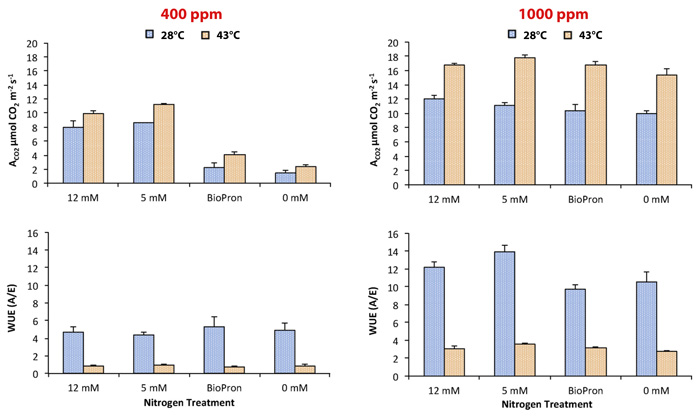| Tweet | Follow @co2science |
Paper Reviewed
Pérez-Jiménez, M., Piñero, M.C. and del Amor, F.M. 2019. Heat shock, high CO2 and nitrogen fertilization effects in pepper plants submitted to elevated temperatures. Scientia Horticulturae 244: 322-329.
Working with sweet pepper (Capsicum annuum, cv. Herminio), Pérez-Jiménez et al. (2019) examined the combined impact of elevated CO2 and heat shock at different levels of nitrogen supply on seedlings of this important agricultural crop.
The experiment was conducted in controlled-environment chambers with the CO2 concentration being maintained at either ambient (400 ppm) or elevated (1000 ppm) levels. Nitrogen (N) treatments included nutrient solutions containing 0, 5 or 12 mM of N. Additionally, a fourth N treatment included 0 mM of N, but with the addition of plant growth-promoting rhizobacteria as a possible N source for the pepper seedlings. Then, after 15 days under these CO2 and N treatment conditions, the researchers induced heat stress by raising the ambient daytime air temperatures from 28°C to a whopping 43°C, maintaining the stressful temperatures for a full 3 days.
Various physiological measurements taken before and at the peak of heat stress allowed the authors to witness multiple beneficial impacts of elevated CO2 on the pepper seedlings. As an example, Pérez-Jiménez et al. report that at the end of the experiment, "plants grown at elevated CO2 were markedly taller and more leafy than those cultivated at ambient CO2." Elevated CO2 also increased the net rate of photosynthesis and the water use efficiencies of the seedlings regardless of N treatment, as illustrated in the figure below.
The scientists also report that high temperature stress "did not lead to any measurable stress in the sweet pepper plants." In contrast, because there was an adequate supply of water, it "augmented photosynthesis" and other key physiological functions. Pérez-Jiménez et al. also found that elevated CO2 "was able to ameliorate the damage in N-starved plants [under high temperature stress], thereby making a difference to plant survival."
In commenting on their several findings, the authors conclude that "elevated CO2 and heat action are two promoters of plant growth and development which, under climate change, might suppose also the avoidance of increasing drought and salinity stress and contamination of water reserved by N." And that would suggest a win-win scenario for sweet pepper plants if both temperature and CO2 levels rise in the future.

Figure 1. Effects of heat shock and elevated CO2 (1000 ppm) on net photosynthesis (ACO2) and water use efficiency (WUE) in leaves of sweet pepper plants under different nitrogen treatments (12 mM, 5 mM, 0mM+PGPR, 0 mM of N) before (28 °C) and after heat shock (43 °C). Values are means ± SE. Adapted from Pérez-Jiménez et al. (2019).




